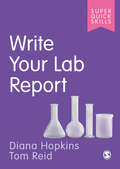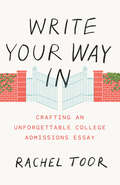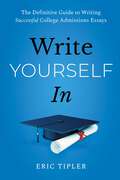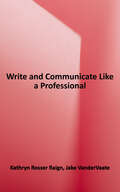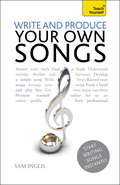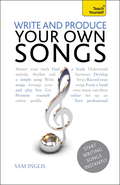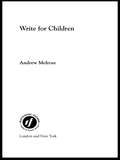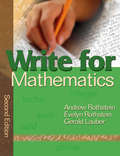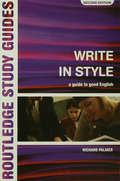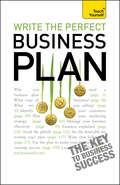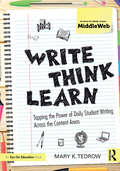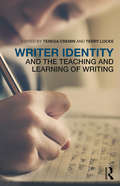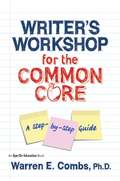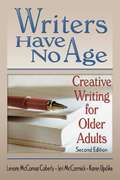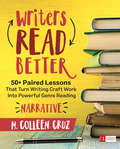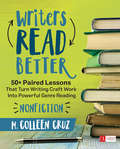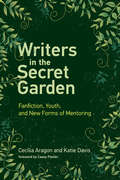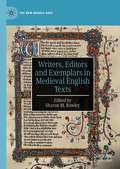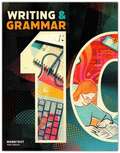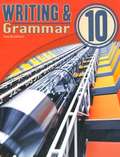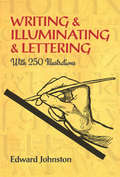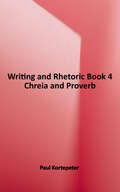- Table View
- List View
Write Your Lab Report (Super Quick Skills)
by Diana Hopkins Tom ReidLab reports are used across a range of subjects, and they require very different skills to writing essays or literature reviews. Get the know-how you need to avoid losing marks and write your report with ease. Understand the structure so you know what’s different before you start Avoid wasting time with insider tips on style and content Check your final report so you submit your best work. Super Quick Skills provides the essential building blocks you need to succeed at university - fast. Packed with practical, positive advice on core academic and life skills, you’ll discover focused tips and strategies to use straight away. Whether it’s writing great essays, understanding referencing or managing your wellbeing, find out how to build good habits and progress your skills throughout your studies. Learn core skills quickly Apply them right away and see results Succeed in your studies and in life Super Quick Skills gives you the foundations you need to confidently navigate the ups and downs of university life.
Write Your Lab Report (Super Quick Skills)
by Diana Hopkins Tom ReidLab reports are used across a range of subjects, and they require very different skills to writing essays or literature reviews. Get the know-how you need to avoid losing marks and write your report with ease. Understand the structure so you know what’s different before you start Avoid wasting time with insider tips on style and content Check your final report so you submit your best work. Super Quick Skills provides the essential building blocks you need to succeed at university - fast. Packed with practical, positive advice on core academic and life skills, you’ll discover focused tips and strategies to use straight away. Whether it’s writing great essays, understanding referencing or managing your wellbeing, find out how to build good habits and progress your skills throughout your studies. Learn core skills quickly Apply them right away and see results Succeed in your studies and in life Super Quick Skills gives you the foundations you need to confidently navigate the ups and downs of university life.
Write Your Way In: Crafting an Unforgettable College Admissions Essay (Chicago Guides to Writing, Editing, and Publishing)
by Rachel ToorWriting, for most of us, is bound up with anxiety. It’s even worse when it feels like your whole future—or at least where you’ll spend the next four years in college—is on the line. It’s easy to understand why so many high school seniors put off working on their applications until the last minute or end up with a generic and clichéd essay. The good news? You already have the “secret sauce” for crafting a compelling personal essay: your own experiences and your unique voice. The best essays rarely catalog how students have succeeded or achieved. Good writing shows the reader how you’ve struggled and describes mistakes you’ve made. Excellent essays express what you’re fired up about, illustrate how you think, and illuminate the ways you’ve grown. More than twenty million students apply to college every year; many of them look similar in terms of test scores, grades, courses taken, extracurricular activities. Admissions officers wade through piles of files. As an applicant, you need to think about what will interest an exhausted reader. What can you write that will make her argue to admit you instead of the thousands of other applicants? A good essay will be conversational and rich in vivid details, and it could only be written by one person—you. This book will help you figure out how to find and present the best in yourself. You’ll acquire some useful tools for writing well—and may even have fun—in the process.
Write Yourself In: The Definitive Guide to Writing Successful College Admissions Essays
by Eric TiplerWrite authentic, memorable college essays that will help you get into the right school for you with this guidebook from a veteran college admissions expert.Every spring, over one million high school juniors embark on an annual rite of passage: applying to college. And with college admission rates at an all-time low, getting into a competitive school is now tougher than ever. At the top schools, a strong transcript and great test scores will get your application noticed, but it&’s your essays, and the personal story that they highlight, that will get you admitted. But often, students don&’t know where to start. Teens fret over topics because they don&’t know what college admissions officers are looking for. They bend over backwards to write what they think colleges want to read, instead of telling their authentic story—which is what admissions officers actually want—in a way that will resonate with their readers. They also struggle because college essays, which are narrative, first-person, and introspective require a different set of skills from academic, expository writing they&’ve been learning for years in the classroom. Seasoned college admissions expert and educator Eric Tipler has seen this firsthand. Teens and their parents spend countless, anxiety-filled hours crafting and refining essays that are often lackluster. In Write Yourself In, Tipler meets students where they are, and provides comprehensive actionable advice in a warm and conversational tone. He demonstrates how to craft a winning essay, one that is authentic, vulnerable, and demonstrative of qualities like personal growth and emotional maturity. Instead of formulas, Write Yourself In gives students step-by-step processes for brainstorming, outlining, writing, and revising essays. It encourages them to seek out feedback at key points in the process, something Tipler has found to be vital to helping students produce their best writing. Further, the book includes sidebars that teach essential components of good storytelling, a &“secret weapon&” in the admissions process. In addition to the admissions essay, Write Yourself In also covers the most common supplemental essays on topics like community, diversity, openness to others&’ viewpoints, and why their school is a good fit for the student scholarship essays, as well as scholarship essays. Tipler includes sections that address current topics like the widespread use of ChatGPT and the discussion of race in the admissions essay, a facet of the student&’s application that will have newfound importance given the Supreme Court decision on affirmative action. Written with both the parent and teen in mind, Write Yourself In is the go-to handbook for writing a great college essay.
Write and Communicate Like a Professional
by Kathryn Rosser Raign Jake VanderVaateThis book is for the introductory technical writing student seeking to improve their writing and communication. The book covers how to improve professional style and tone, develop professional documents, work in teams, and plan and execute multiweek projects. It also includes various types of professional writing―such as letters, texts, handbooks, reports, agendas, press releases, and newsletters―while focusing on those communication forms used most often: emails, memos, and short reports. Authors Kathryn Raign and Jake VanderVaate also cover such important communication skills as collaborative writing in a chapter on sharing and giving feedback. With clear graphics, clever problem-solution rubrics, and the latest coverage of informal technical writing delivered through social media formats of email and text, Write and Communicate Like a Professional is essential reading for your professional success.
Write and Produce Your Own Songs: Audio eBook
by Sam InglisIs this the right book for me?This book is an essential companion for any aspiring songwriter, and is ideal for those with no formal musical education. Covering every genre of popular contemporary music, from rock and pop to musical theatre and country/western, it tracks everything from what harnessing your creative potential to finding a hook and selling, performing and promoting your songs. It also offers some material for those at a slightly more advanced level who'd like to understand things such as chords and sequencing. With straightforward notation and embedded audio which showcases the process at work, this accessible guide from a professional songwriter will prove indispensable for creating and peforming your own songs.Write and Produce Your Own Songs includes:Chapter 1: Tools of the tradeChapter 2: HooksChapter 3: Basic theoryChapter 4: Developing a hookChapter 5: Developing lyricsChapter 6: Song structureChapter 7: Arranging and recording your songsChapter 8: Playing live and forming a bandChapter 9: Promoting your music on the InternetChapter 10: The professional songwriteLearn effortlessly with a new easy-to-read page design and added features: Not got much time?One, five and ten-minute introductions to key principles to get you started.Author insightsLots of instant help with common problems and quick tips for success, based on the author's many years of experience.Test yourselfTests in the book and online to keep track of your progress.Extend your knowledgeExtra online articles to give you a richer understanding of the subject.Five things to rememberQuick refreshers to help you remember the key facts.Try thisInnovative exercises illustrate what you've learnt and how to use it.
Write and Produce Your Own Songs: Teach Yourself
by Sam InglisIs this the right book for me?This book is an essential companion for any aspiring songwriter, and is ideal for those with no formal musical education. Covering every genre of popular contemporary music, from rock and pop to musical theatre and country/western, it tracks everything from what harnessing your creative potential to finding a hook and selling, performing and promoting your songs. It also offers some material for those at a slightly more advanced level who'd like to understand things such as chords and sequencing. With straightforward notation and embedded audio which showcases the process at work, this accessible guide from a professional songwriter will prove indispensable for creating and peforming your own songs.Write and Produce Your Own Songs includes:Chapter 1: Tools of the tradeChapter 2: HooksChapter 3: Basic theoryChapter 4: Developing a hookChapter 5: Developing lyricsChapter 6: Song structureChapter 7: Arranging and recording your songsChapter 8: Playing live and forming a bandChapter 9: Promoting your music on the InternetChapter 10: The professional songwriteLearn effortlessly with a new easy-to-read page design and added features: Not got much time?One, five and ten-minute introductions to key principles to get you started.Author insightsLots of instant help with common problems and quick tips for success, based on the author's many years of experience.Test yourselfTests in the book and online to keep track of your progress.Extend your knowledgeExtra online articles to give you a richer understanding of the subject.Five things to rememberQuick refreshers to help you remember the key facts.Try thisInnovative exercises illustrate what you've learnt and how to use it.
Write for Children: Exploring Contemporary Issues In Writing For Children
by Andrew MelroseWriting for children is not about writing little stories, it is about writing big stories, shorter. Children's literature is an art form in its own right, and this book is for everyone who wants not just to write for children, but to write well for them. This short guide to creative writing for children is based on the author's own successful MA course. Andrew Melrose provides guidance on every aspect of the process of writing for children. He stresses the importance of 'writing for' the child and not 'writing to or at' them. Literacy and learning depend on writing and reading and it is therefore the responsibility of the writer to understand who they are writing for. The book is divided into four sections which cover all aspects of the writing process.This book goes far beyond the 'how to' format to help writers learn the finely balanced craft of writing for children. It will be an indispensable handbook for aspiring and practising children's authors.
Write for Mathematics
by Andrew S. Rothstein Evelyn B. Rothstein Gerald LauberAddressing NCTM standards, this second edition offers a wide range of practical writing strategies to help students deepen their understanding of mathematical concepts and theories.
Write in Style: A guide to good English
by Richard PalmerWrite in Style is aimed at all for whom clarity and accuracy of expression are important skills. All the main styles and grammaticalrules are covered, their sense axplained and vivid examples given of how not to write. Plenty of sound and meticulous advice is offered in a friendly and enthusiastic toneand a large part of the book covers specific types of writing, from essays and articles to minutes and reportage. The many illustrations, examples and exercises throughout help the reader put into practice the techniques and skillds the book explores.
Write the Perfect Business Plan: Teach Yourself (Ty Business Skills Ser.)
by Polly BirdBusinesses involved in preparing a business plan need guidance on what to present, and how to present it. This book is primarily aimed at new businesses and the self-employed, but it will also be useful to any business that has to raise a financial case during the course of their trading. Straightforward advice is given about what to consider and include in the plan, and how to present it.NOT GOT MUCH TIME?One, five and ten-minute introductions to key principles to get you started.AUTHOR INSIGHTSLots of instant help with common problems and quick tips for success, based on the author's many years of experience.TEST YOURSELFTests in the book and online to keep track of your progress.EXTEND YOUR KNOWLEDGEExtra online articles at www.teachyourself.com to give you a richer understanding of business planning.THINGS TO REMEMBERQuick refreshers to help you remember the key facts.TRY THISInnovative exercises illustrate what you've learnt and how to use it.
Write, Think, Learn: Tapping the Power of Daily Student Writing Across the Content Areas
by Mary K. TedrowFind out how to create the climate and space for everyday student writing. In this new co-publication with MiddleWeb, award-winning teacher Mary Tedrow shows you how to encourage students to integrate daily writing into their lives, leading to improved critical thinking skills, increased knowledge of subject areas, and greater confidence in written expression. This practical guide will help you consider the unique needs of your students, while still meeting state standards. You’ll discover how to… Develop classroom routines and activities that invite creativity and self-expression Teach writing methods that can be used across different grade levels and all content areas Challenge students to examine their own writing processes for thinking and problem solving Evaluate written work in a way that emphasizes growth over grades Many exercises, prompts, and attempts at thinking found in the book can be easily adapted for use both in and out of the classroom. Whether you are a new or experienced teacher, Write, Think, Learn will enable you to make writing come alive for all your students.
Writer Identity and the Teaching and Learning of Writing
by Teresa Cremin Terry LockeWriter Identity and the Teaching and Learning of Writing is a groundbreaking book which addresses what it really means to identify as a writer in educational contexts and the implications for writing pedagogy. It conceptualises writers’ identities, and draws upon empirical studies to explore their construction, enactment and performance. Focusing largely on teachers’ identities and practices as writers and the writer identities of primary and secondary students, it also encompasses the perspectives of professional writers and highlights promising new directions for research. With four interlinked sections, this book offers: Nuanced understandings of how writer identities are shaped and formed; Insights into how classroom practice changes when teachers position themselves as writers alongside their students; New understandings of what this positioning means for students’ identities as writers and writing pedagogy; and Illuminating case studies mapping young people's writing trajectories. With an international team of contributors, the book offers a global perspective on this vital topic, and makes a new and strongly theorised contribution to the field. Viewing writer identity as fluid and multifaceted, this book is important reading for practising teachers, student teachers, educational researchers and practitioners currently undertaking postgraduate studies. Contributors include: Teresa Cremin, Terry Locke, Sally Baker, Josephine Brady, Diane Collier, Nikolaj Elf, Ian Eyres, Theresa Lillis, Marilyn McKinney, Denise Morgan, Debra Myhill, Mary Ryan, Kristin Stang, Chris Street, Anne Whitney and Rebecca Woodard.
Writer's Workshop for the Common Core: A Step-by-Step Guide
by Warren CombsWriting instruction expert Warren Combs presents a step-by-step plan for teaching writing workshops that are aligned to the Common Core State Standards. The book is filled with practical mini-lessons, strategies, and tools for every stage of the writing process, from prewriting through publication. Scripting is provided, to show teachers how to model each strategy for students. In addition, Dr. Combs shows how teachers can use the following elements: The concepts Voice, Pictures, and Flow, to help students understand the essential elements of writing; The words Invite, Model, Write, Look, and Learn, to model effective writing for students and have them learn from your example; Revision strategies such as Jot and Blend, Combining Sentences, Writing Leads, and Writing Closes; Peer revision using Peer-Assisted Learning Systems (PALS); Student self-assessment rubrics. The book also includes scoring guides and pacing guides, to help teachers implement writing workshops more easily. As Dr. Combs demonstrates, you can give workshops more structure while still making writing come alive for your students.
Writers Have No Age: Creative Writing for Older Adults, Second Edition
by Karen Updike Jeri Mccormick Lenore Mccomas CoberlyWriters Have No Age: Creative Writing for Older Adults, Second Edition is a book for writers by writers. Unlike the first edition, which was aimed at teachers of writing, this edition is aimed at writers themselves. This book will help older writers value themselves and their potential, and increase the pleasure and satisfaction found in writing. It provides both information and inspiration gained from the authors&’ own writing lives and from observation of their students that will help boost writing confidence.Write your way to success-at any age!"We who come to writing do not have to be convinced that there are rewards in store for us. We sense good things ahead and believe in writing&’s benefits." "In this book we have put together some of our own best writing and teaching ideas to help you enjoy the re-creation and stimulation of writing, whatever your age.""Older writers though we are, we do get better at it all the time."-the authors This book combines personal accounts of the authors&’ writing experiences as well as writing instruction and information. It contains numerous writing exercises and assignments to get you started and techniques to keep you at it. It also includes sections that cover all types of writing, including poetry, fiction, and nonfiction. Marketing resources for writers who wish to be published are included.In Writers Have No Age, you will find: authors&’ personal anecdotes-from disappointment to success writing exercises and techniques marketing resources and mediums for writers an editing checklist a list of books and periodicals to help hone writing skills suggestions on teaching or volunteering in nursing homes and much more!Writers Have No Age is a valuable tool for anyone in (or just getting started in) the writing field. Not only will this book help beginners sharpen their writing skills, but it will also help those who have written professionally or personally to reach a wider audience. Add this book to your collection today, and write your way to success!
Writers Read Better: 50+ Paired Lessons That Turn Writing Craft Work Into Powerful Genre Reading (Corwin Literacy)
by M. Colleen CruzWhen It Comes to Reading, Writers Have an Advantage We know that writing skills reinforce reading skills, but what’s the best way to capitalize on this relationship? By flipping the traditional “reading lesson first, writing lesson second” sequence, Colleen Cruz helps you make the most of the writing-to-reading connection with 50 carefully matched lesson pairs centered around narrative texts. Lessons can be implemented either as a complete curriculum or as a supplement to an existing program. Complete with suggestions on adapting the lessons to suit the needs of your classroom and individual students, Writers Reader Better: Narrative offers a solid foundation for giving your students the advantage of transferable literacy skills.
Writers Read Better: 50+ Paired Lessons That Turn Writing Craft Work Into Powerful Genre Reading (Corwin Literacy)
by M. Colleen CruzWhen It Comes to Reading, Writers Have an Advantage We know that writing skills reinforce reading skills, but what’s the best way to capitalize on this relationship? By flipping the traditional “reading lesson first, writing lesson second” sequence, Colleen Cruz helps you make the most of the writing-to-reading connection with 50 carefully matched lesson pairs centered around narrative texts. Lessons can be implemented either as a complete curriculum or as a supplement to an existing program. Complete with suggestions on adapting the lessons to suit the needs of your classroom and individual students, Writers Reader Better: Narrative offers a solid foundation for giving your students the advantage of transferable literacy skills.
Writers Read Better: 50+ Paired Lessons That Turn Writing Craft Work Into Powerful Genre Reading (Corwin Literacy)
by M. Colleen CruzWe know that writing skills reinforce reading skills, but what’s the best way to capitalize on this beneficial relationship? By flipping the traditional "reading lesson first, writing lesson second" sequence, Colleen Cruz ingeniously helps you make the most of the writing-to-reading connection with carefully matched, conceptually connected lesson pairs. The result is a healthy reciprocity that effectively and efficiently develops students’ literacy skills. Backed by long-term academic and field research, Writers Read Better presents a series of 50 tightly interconnected lesson pairs that can be implemented either as supplement existing curriculum or as a stand alone module. Each pairing leads with a writing lesson, used as a springboard for the reading lesson that will follow. Throughout the book’s four sections, organized to cover distinct and complementary phases of working with non-fiction texts, you’ll discover Helpful insights on preparing for the section’s overarching goals Clear guidance on the intention of each lesson, what materials are required, and step-by-step plans for leading the activity Sample teacher language for leading the lesson Tips on building and organizing your classroom library, and how you can incorporate the tools, technology and media available in your classroom to make each lesson most effective Sample student work, online videos and other supporting resources Complete with practical suggestions on adapting the lessons to suit the particular needs of your classroom as well as individual students, Writers Reader Better offers a solid foundation for giving your students the advantage of powerful, transferable literacy skills.
Writers Read Better: 50+ Paired Lessons That Turn Writing Craft Work Into Powerful Genre Reading (Corwin Literacy)
by M. Colleen CruzWe know that writing skills reinforce reading skills, but what’s the best way to capitalize on this beneficial relationship? By flipping the traditional "reading lesson first, writing lesson second" sequence, Colleen Cruz ingeniously helps you make the most of the writing-to-reading connection with carefully matched, conceptually connected lesson pairs. The result is a healthy reciprocity that effectively and efficiently develops students’ literacy skills. Backed by long-term academic and field research, Writers Read Better presents a series of 50 tightly interconnected lesson pairs that can be implemented either as supplement existing curriculum or as a stand alone module. Each pairing leads with a writing lesson, used as a springboard for the reading lesson that will follow. Throughout the book’s four sections, organized to cover distinct and complementary phases of working with non-fiction texts, you’ll discover Helpful insights on preparing for the section’s overarching goals Clear guidance on the intention of each lesson, what materials are required, and step-by-step plans for leading the activity Sample teacher language for leading the lesson Tips on building and organizing your classroom library, and how you can incorporate the tools, technology and media available in your classroom to make each lesson most effective Sample student work, online videos and other supporting resources Complete with practical suggestions on adapting the lessons to suit the particular needs of your classroom as well as individual students, Writers Reader Better offers a solid foundation for giving your students the advantage of powerful, transferable literacy skills.
Writers in the Secret Garden: Fanfiction, Youth, and New Forms of Mentoring (Learning in Large-Scale Environments)
by Katie Davis Cecilia AragonAn in-depth examination of the novel ways young people support and learn from each other though participation in online fanfiction communities.Over the past twenty years, amateur fanfiction writers have published an astonishing amount of fiction in online repositories. More than 1.5 million enthusiastic fanfiction writers—primarily young people in their teens and twenties—have contributed nearly seven million stories and more than 176 million reviews to a single online site, Fanfiction.net. In this book, Cecilia Aragon and Katie Davis provide an in-depth examination of fanfiction writers and fanfiction repositories, finding that these sites are not shallow agglomerations and regurgitations of pop culture but rather online spaces for sophisticated and informal learning. Through their participation in online fanfiction communities, young people find ways to support and learn from one another. Aragon and Davis term this novel system of interactive advice and instruction distributed mentoring, and describe its seven attributes, each of which is supported by an aspect of networked technologies: aggregation, accretion, acceleration, abundance, availability, asynchronicity, and affect. Employing an innovative combination of qualitative and quantitative analyses, they provide an in-depth ethnography, reporting on a nine-month study of three fanfiction sites, and offer a quantitative analysis of lexical diversity in the 61.5 billion words on the Fanfiction.net site. Going beyond fandom, Aragon and Davis consider how distributed mentoring could improve not only other online learning platforms but also formal writing instruction in schools.
Writers, Editors and Exemplars in Medieval English Texts (The New Middle Ages)
by Sharon M. RowleyThis collection of essays explores the literary legacy of medieval England by examining the writers, editors and exemplars of medieval English texts. In order to better understand the human agency, creativity and forms of sanctity of medieval England, these essays investigate both the production of medieval texts and the people whose hands and minds created, altered and/or published them. The chapters consider the writings of major authors such as Chaucer, Gower and Wyclif in relation to texts, authors and ideals less well-known today, and in light of the translation and interpretive reproduction of the Bible in Middle English. The essays make some texts available for the first time in print, and examine the roles of historical scholars in the construction of medieval English literature and textual cultures. By doing so, this collection investigates what it means to recover, study and represent some of the key medieval English texts that continue to influence us today.
Writing & Grammar Grade 10 Student Text (Fourth Edition)
by Bob Jones UniversityThis updated fourth edition of BJU Press' Writing and Grammar, Grade 10 student text features full-color pages with historical examples and context from all eras. Charts, sample sentences, enrichment focusing on thinking skills and Bible letters, and ESL notes all provide additional insights and interest to the chapter's primary focus. Lessons feature an excerpt, grammar exercises, and writing activities. This grade 10 text covers parts of speech, sentences, phrases, clauses, agreement, verb use, pronoun reference, capitalization, punctuation, writing, library skills, study skills, and more.
Writing & Illuminating & Lettering: With 250 Illustrations
by Edward JohnstonOne of the founders of modern calligraphy, Edward Johnston regarded lettering, writing, and illuminating as not only desirable ends in themselves but also as practical avenues to mastery of typography, decoration, and design. In this classic, profusely illustrated guide, he distilled his expertise into a series of easy-to-follow lessons that will benefit any student of calligraphy, book design, or art.Part I is devoted to writing and illuminating. Early chapters cover the fundamentals of acquiring a formal hand: choosing paper, ink, and quills; holding the pen; spacing and planning a manuscript; and more. The author then turns to the techniques of producing a manuscript book: tools and materials, methods and proportions, margins, and other methods. Part II offers a detailed discussion of lettering: the qualities of good lettering, methods of construction and arrangement, spacing, proportion, and other matters. Two appendixes cover the uses of lettering in book bindings, wall inscriptions, monograms, and title pages as well as the techniques involved in lettering on metal, wood, and stone.
Writing & Rhetoric Book 4: Chreia & Proverb
by Paul KortepeterThe Writing and Rhetoric series method employs fluent reading, careful listening, models for imitation, and progressive steps. It assumes that students learn best by reading excellent, whole-story examples of literature and by growing their skills through imitation. Each exercise is intended to impart a skill (or tool) that can be employed in all kinds of writing and speaking. The exercises are arranged from simple to more complex. What's more, the exercises are cumulative, meaning that later exercises incorporate the skills acquired in preceding exercises. This series is a step-by-step apprenticeship in the art of writing and rhetoric.
